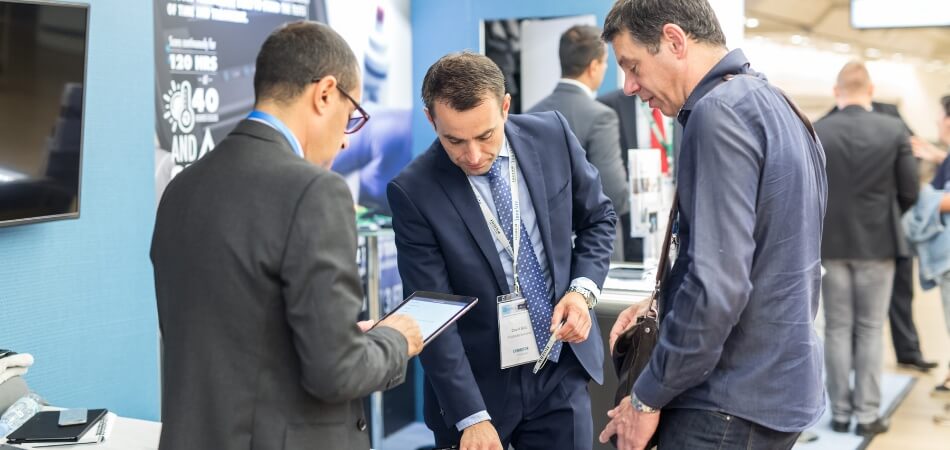Trade shows are dynamic platforms where businesses showcase their latest products and innovations, attracting a diverse array of industry professionals and potential customers. Understanding the financial impact of these events is crucial, and a common question arises: What is the average ROI from trade shows?
Recent data reveals an encouraging picture. For dedicated participants, around 5 to 10% of trade show leads can successfully convert, signifying a substantial opportunity for business growth. Impressively, among Fortune 500 companies, 14% have reported a remarkable 5:1 ROI, indicating that for every dollar invested, five dollars were earned.
This statistic highlights the potential profitability and effectiveness of trade show participation. To delve deeper into how these figures are achieved and to explore strategies for maximizing trade show ROI, continue reading our comprehensive guide.
What the Trade Show is About?
Trade shows serve as bustling hubs for industry advancements, where businesses unveil new products and network with potential clients. These events offer a unique platform for companies to demonstrate their latest innovations and foster professional connections. The atmosphere is charged with excitement, as exhibitors and attendees alike explore cutting-edge developments.

The primary focus of a trade show is to facilitate business-to-business interactions, enabling companies to expand their market reach. Exhibitors utilize this opportunity to showcase their products, hoping to attract new customers and partners. Attendees, ranging from industry experts to potential buyers, seek to discover new trends and solutions.
In essence, trade shows are pivotal for businesses seeking to strengthen their industry presence. They provide a rare chance for direct engagement with a target audience, essential for marketing and sales strategies. The event’s success hinges on effective networking and the ability to captivate the interest of attendees.
Requirements for Trade Shows to Have Good Average ROI
A strong average ROI can be achieved from trade shows if certain prerequisites are met. These events aren’t just about attendance; they demand strategic planning and execution. The following points highlight key requirements for ensuring a successful trade show experience with a positive return on investment.
- Effective pre-show marketing is crucial to generate interest and awareness. Inform potential attendees about your presence and offerings well in advance.
- A well-designed, engaging booth can attract more visitors. It should be visually appealing and reflective of your brand identity.
- Trained, enthusiastic staff are pivotal for making meaningful connections. They should be knowledgeable about your products and skilled in communication.
- Follow-up post-show is as important as the event itself. Quick, personalized follow-ups with leads can significantly enhance conversion rates.
- Measuring performance and gathering feedback is essential for improvement. Analyze the success of your participation to refine future strategies.
Optimizing trade show ROI requires a blend of creative marketing, engaging presentation, skilled personnel, diligent follow-up, and thorough analysis. Adhering to these guidelines can transform trade show participation into a lucrative investment.
What is the Average ROI from Trade Shows?
Understanding the average ROI from trade shows is vital for businesses contemplating investment in these events. Trade shows provide a unique platform for networking, brand promotion, and lead generation. However, the return on investment (ROI) can vary significantly based on several factors.

Typically, businesses that actively engage and follow up can see 5 to 10% of their trade show leads convert. This conversion rate indicates a noteworthy potential for sales and networking opportunities. Among Fortune 500 companies, a subset reports an impressive 5:1 ROI from trade shows. This means they earn $5 for every $1 spent, showcasing the high potential for returns.
However, achieving such ROI demands strategic planning, effective booth design, and skilled staff engagement. It’s not solely about participation; it’s about how well you utilize the opportunity. Hence, while the average ROI can be promising, it largely depends on the effort and strategy employed by the exhibitors. Understanding and implementing these elements are key to maximizing trade show investments.
Factors that Affect the Average ROI of a Trade Show
Multiple factors influence the average ROI of a trade show, each playing a critical role in the event’s success. From pre-event planning to post-event follow-up, these elements determine the overall effectiveness and profitability. Understanding these factors can help businesses maximize their trade show investments. Here are the factors:
Quality of Booth Design and Location
A well-designed booth in a prime location can significantly increase visitor traffic. An attractive, strategically placed exhibit draws more attention, enhancing brand visibility. The booth’s design should reflect the company’s image and effectively showcase products or services. Location within the trade show also matters as high-traffic areas lead to more interactions.
Staff Training and Engagement
The expertise and engagement level of the staff at the booth are crucial. Knowledgeable, approachable staff can effectively communicate your brand’s value proposition. They should be adept at initiating conversations and capturing lead information. Well-trained personnel are essential for converting booth visits into tangible business opportunities.
Pre- and Post-Show Marketing Efforts
Effective marketing before and after the trade show influences ROI. Pre-show promotions can generate interest and drive traffic to your booth. Post-show follow-up is essential to convert leads into customers. A cohesive marketing strategy encompassing both phases is critical for success.
Target Audience and Lead Quality
Matching the trade show’s audience with your target market is fundamental. Ensuring the event attracts your ideal customer profile increases the chances of high-quality leads. The quality of leads, not just the quantity, affects the conversion rate and ROI. Focusing on targeted, relevant audiences yields better results.
In summary, the average ROI of a trade show is not a fixed metric; various factors shape it. From booth design to staff competency, pre-event marketing to lead quality, each element plays a vital role. By understanding and optimizing these factors, businesses can significantly enhance their trade show success and ROI.
Types of Trade Shows that Earn Good ROI
Trade shows come in various formats, each offering unique opportunities for businesses to achieve a good return on investment (ROI). The type of trade show significantly influences potential returns, with certain formats being more conducive to high ROI. In this context, it’s essential to understand which types of trade shows are most effective.
Industry-Specific Trade Shows
Shows focusing on specific industries often yield high ROI due to targeted audiences. These events attract attendees deeply interested in the niche, increasing the relevance of leads. Exhibitors can tailor their presentations to a knowledgeable audience, enhancing engagement. Industry-specific trade shows are ideal for businesses looking for quality over quantity in leads.
Global Expos
Global Expos, such as the renowned World Expo, offers vast exposure to diverse international audiences. Participating in these events can catapult a brand onto the global stage. The diverse attendee base provides opportunities for cross-border networking and partnerships. Global Expos are particularly beneficial for companies seeking international expansion and recognition.
Consumer Trade Shows
Consumer trade shows directly target the end-user, making them excellent for immediate sales and feedback. They are ideal for businesses that sell directly to consumers. These shows allow for real-time interaction with the product and instant feedback. Consumer trade shows are great for companies looking to boost sales and brand awareness simultaneously.
Technology and Innovation Expos
Shows focusing on technology and innovation draw attendees interested in the latest industry advancements. These expos are hotspots for startups and tech giants alike, offering opportunities for cutting-edge presentations. They are ideal for showcasing new inventions or software attracting investors and collaborators. Technology expos are key for businesses at the forefront of innovation.
Choosing the right type of trade show is crucial for maximizing ROI. Whether it’s an industry-specific event, a Global Expo, a consumer-focused show, or a technology expo, aligning the event’s nature with business objectives is vital. Understanding the audience and purpose of each type of trade show can significantly enhance the chances of successful and profitable participation.
Tips to Increase the ROI for a Trade Show
Maximizing the return on investment (ROI) from trade shows is a key objective for businesses participating in these events. In order to achieve this, certain strategies and practices must be implemented effectively. Here, we outline essential tips that can significantly increase the ROI from trade shows:

- Strategic Booth Location and Design: Choosing a high-traffic location and designing an engaging booth can significantly attract more visitors. An appealing design that resonates with your brand identity is crucial for making a lasting impression.
- Pre-Show Marketing and Appointments: Engage in pre-show marketing to create buzz and schedule appointments with key prospects before the event. Utilize social media, email campaigns, and personal invitations to inform and attract attendees.
- Skilled and Trained Staff: Ensure your staff is well-trained in product knowledge and customer engagement techniques. Friendly, knowledgeable staff can effectively communicate your brand’s value and capture leads.
- Effective Lead Capture Strategy: Implement a robust system for capturing and qualifying leads during the show. Use digital tools or traditional methods to efficiently gather lead information for post-show follow-up.
- Post-Show Follow-Up Plan: Develop a timely and personalized follow-up plan for leads collected at the show. Quick, relevant communication can significantly increase conversion rates from leads to customers.
- Performance Measurement and Analysis: Evaluate your trade show performance by analyzing metrics like lead quantity, quality, and conversion rates. Use this data to refine strategies for future shows and improve ROI.
Increasing ROI from trade shows requires a combination of strategic planning, effective marketing, skilled staffing, efficient lead capture, diligent follow-up, and thorough performance analysis. By implementing these tips, businesses can optimize their trade show experiences and achieve greater returns on their investment.
Final Considerations
Analyzing the dynamics of trade shows reveals their potential as powerful platforms for business growth. Addressing the key query, “What is the average ROI from trade shows?” requires an appreciation of various influencing factors. Insights show that dedicated engagement can lead to a 5 to 10% lead conversion rate, with select Fortune 500 companies achieving an impressive 5:1 ROI.
The key to this success lies in detailed strategies encompassing effective booth design, proficient staff, and comprehensive marketing. Different trade show types offer distinct opportunities for ROI, emphasizing the need for a tailored approach.
The art of maximizing ROI from these events is a blend of strategic planning and practical application, tailored to align with the specific goals of a business and the nature of the trade show it participates in.


